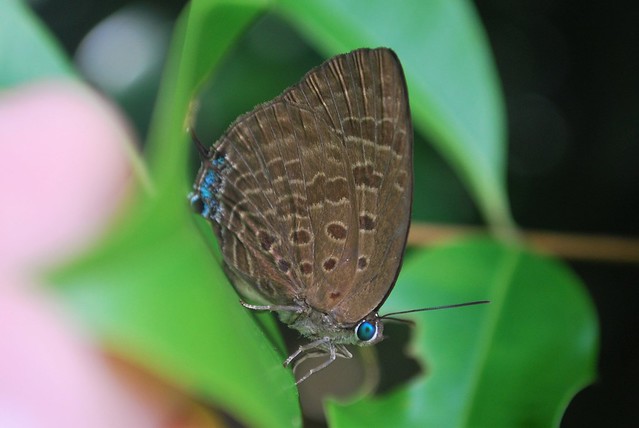I'm pretty sure these are all A. athada. Just need confirmation. Thanks
All of them were taken on separate occasions
Arhopala athada best cropped edited-min.jpg

I'm pretty sure these are all A. athada. Just need confirmation. Thanks
All of them were taken on separate occasions
Arhopala athada best cropped edited-min.jpg

Aaron Soh
Now for the really tough alea subgroup spp...
This looks like A. sublustris ridleyi but with spot 3 on the forewing unusually small
sublustris best cropped edited resized-min.jpg
At first i thought this was sublustris but i noticed some differences between this and the other one above which i subsequently shot. All the spots, especially on the forewing post-discal band are very slightly wider and slightly more angular also so i suspect this could be A. milleri but there's probably no way to be certain.
cf milleri 1 best cropped edited resized-min.jpg
Finally, a female, which will probably forever remain unidentified
cf milleri 2 best cropped edited resized-min.jpg
All three were shot in the same area roughly 50 m apart. The 2nd and 3rd were taken close by within minutes of each other, while the first was taken slightly further away and about 3 weeks after the other two. IDs greatly appreciated(Compression has reduced the quality somewhat. Soz about that)
Aaron Soh
Post 1.
Yes they are all A. athada.
HW spot 6 is typically astride spot 5 & cellend bar ; Always wide spacing between HW submarginal & postdiscal spots.
V spot fatter usually, than other cleander subgroup members, silhetensis, cleander, zambra.
Post 2.
You can see a bit of the upperside in pix 1 & 2. The blue is reflective.
This indicate 1 & 2 are sublustris.
The upperside of A. milleri is a matt(non-reflective) indigo blue.
Probably like this without a purple tone.
https://qph.fs.quoracdn.net/main-qim...2f9ded645103-c
The 3rd is of course very hard to say. A good guess is still A. sublustris.
TL Seow: Cheers.
Thanks for the help, Dr Seow. Knowing the extent of variability will really help for future identifications; unfortunately there aren't many resources for the alea subgroup for comparison.
sublustris seems quite variable ventrally.
Aaron Soh
Shot this today. The two dorsals were taken hours apart but i think they're the same individual because of the way they're torn. The dorsal blue is quite muted (i didn't adjust the colours).
The post-discal band on the forewing seems very strange to me. Probably either A. milleri or evansi? It was really shifty so i couldn't get good close-ups. C&P4 claims evansi has a pinkish wash but i find this really hard to judge
Arhopala best 1 cropped edited resized.jpg
dorsal 1 cropped edited resized.jpg
dorsal 2 best cropped edited resized.jpg
Aaron Soh
It looks like you have the rare A. milleri.
The upperside is described in C&P4 as a 'more matt darker indigo blue'. It is not totally non-reflective.
I have seen a number of A. sublustrus uppersides & this is definitely not it.
Most A. milleri have FW spot 9 in line with the band while in A sublusris it is more often shifted in.
Another member recorded in Singapore is A. phanda
The upperside is dark reflective blue & on the underside spot 6 & 7 are like a column.
This one below from Langkawi should be A. evansi.
http://2.bp.blogspot.com/-U0frSBVwK-...ala+evansi.jpg
TL Seow: Cheers.
Thanks for the confirmation, Dr Seow.
Regarding this subgroup i have a few questions:
1. Does it matter whether the post-discal band on the forewing is dislocated at vein 3?
2. Does it matter whether spot 2 in the hindwing submarginal series(beside the tail) is shifted out, or how much it's shifted out?
Seems like these two features are quite inconsistent
Aaron Soh
1. I believed you mean vein 4 which the vein directly below spot 4.
The only value stated is between A. cleander & athada ,where in cleander the band is usually continuous or slightly kinked, while in athada it is variously dislocated.
2. This have no value.
TL Seow: Cheers.
Thanks Dr Seow. I was very baffled by the hindwing spot 2
Aaron Soh
Perhaps it might be of some use.
In most cases HW spot 2 is slightly or partially dislocated from spot 3.
In A. phaenops it seem to be nearly more so.
It may be a useful point of exclusion ID ie. if HW spot 2 is only partially or dislocated halfway from spot 3, it can not be A. phaenops.
TL Seow: Cheers.